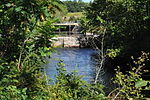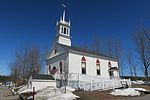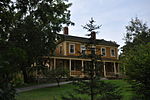Little River (Presumpscot River tributary)
Buxton, MaineGorham, MaineMaine river stubsRivers of Cumberland County, MaineRivers of Maine ... and 2 more
Rivers of York County, MaineWindham, Maine
The Little River is an 18.8-mile-long (30.3 km) tributary of the Presumpscot River in the U.S. state of Maine. It rises in the northern part of the town of Buxton in York County and flows southeast, then northeast into Gorham in Cumberland County. It flows northeast and east across Gorham, reaching the Presumpscot at the eastern boundary of the town, across from Windham.
Excerpt from the Wikipedia article Little River (Presumpscot River tributary) (License: CC BY-SA 3.0, Authors).Little River (Presumpscot River tributary)
Mosher Road,
Geographical coordinates (GPS) Address Website Nearby Places Show on map
Geographical coordinates (GPS)
| Latitude | Longitude |
|---|---|
| N 43.71647 ° | E -70.41088 ° |
Address
Saint Pierre Preserve
Mosher Road
04038
Maine, United States
Open on Google Maps








